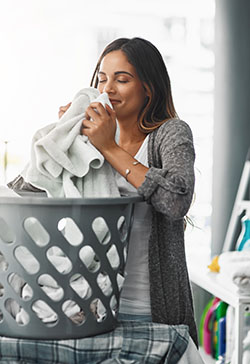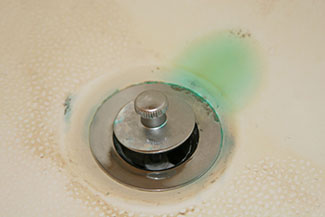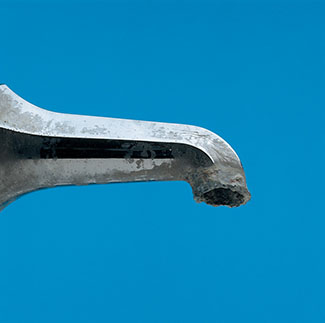Bring Sparkle Back To Your Bathroom & Kitchen Fixtures
Remove Mineral Deposits with a Little Elbow Grease and Determination
You've spent hundreds if not thousands of dollars on new bathroom and kitchen fixtures and appliances. They gleam. They sparkle, You can see your reflection. The water flows in a steady stream and in one direction. You enjoy the bliss for a month, maybe two, only to come face to faucet with... the white stuff. The nemesis of any fastidious housecleaner; #MineralDeposits.
According to a recent U.S. Geological Survey, 85 percent of the United States' geography has hard water. Hard water is water that contains naturally occurring minerals, particularly magnesium and calcium. Hard water and limescale can create water spots and clog pipes. Iron and manganese in the water create rust stains and affect water's taste.

"Any appliance that uses or processes water works less efficiently with hard water," said Mike Mattox, General Manager of Kinetico Water Systems. "You cannot achieve the desired results from dishwashers, washing machines, hot water heaters or even coffeemakers, without using a whole home soft water treatment system."
The Water Quality Association reports laundry costs can double in households using hard water. Clothes become stiff and rough when hard water deposits react with the chemicals in laundry detergents. Because more detergent is needed, colors fade and fabrics wear up to 15 percent faster. More importantly, washing machines can wear out nearly 30 times faster when using hard water.
"We can't control the quality of water coming into our homes, said Mattox. "But we can control the quality of its output by installing a treatment system."
Regardless of whether you install a treatment system, it's important to get rid of the deposits that are already there, gunking-up pipes, fixtures and appliances.
Removing Mineral Build-Up
Here are some simple solutions to get rid of the white residue and bring your fixtures and appliances back to life.
Sink Fixtures
 Fill a small plastic bag halfway with white vinegar.
Fill a small plastic bag halfway with white vinegar.- Attach the bag over the showerhead or faucet with a rubber band.
- Leave it for a few hours.
- Remove the bag and scrub the fixture with a cleaning cloth.
To clean heavily saturated fixtures, remove the aerator and clean with a soft toothbrush and a light vinegar-water mixture. You may need to soak the aerator in vinegar and water for a few hours.
Clogged showerheads
- Follow the directions for the sink fixtures.
For a deeper clean
- Disassemble the fixture
- Sketch a diagram of the fixture as you disassemble it. This will help in putting it back together.
- Soak the fixture and small parts overnight in the vinegar-water solution.
There are commercial products available. But be careful, some finishes can be damaged by chemicals and can cause breathing difficulty if not used in a well-ventilated area.
Shower Doors
Using 0000 or 4/0 grade steel wool (the finest) in combination with CLR and a lot of elbow grease, rub the cleaner in a circular motion. Squeegee or wipe the surface when you reach the desired result. Hardwater etches glass over time. You will not be able to restore the glass to 100 percent, but with work, you can get close.
Dishwasher

Fill a small container with one cup of distilled white vinegar on both the top and bottom racks and run a regular wash cycle. Do not add detergent.
Washing Machine
- Run the largest cycle with hot water in an empty tub.
- Use 1/2 – 1 cup of vinegar to run inside your machine for the first few minutes.
- Then add 1/2 cup of baking soda.
- Wipe down the inside of the machine in a temporary pause of the cycle.
- Run the cycle completely (without clothes in the machine). The rinse cycle will remove the vinegar and baking soda.
- Clean the areas that hold softener and bleach with a clean rag or toothbrush.
You may notice an improvement in how the water drains.
Refrigerator Ice Dispenser
- Moisten three to five paper towels with full-strength white vinegar. Do not wring out the towels.
- Drape the paper towels over the different parts of the ice dispenser.
- Remove the overflow pan. Drape soaked paper towels on it and the inside of where the pan sits.
- Let the paper towels sit for at least one hour to loosen the calcium deposits.
- Remove the paper towels and toss them in the garbage.
- Pour 1 tbsp. of lemon juice in a bowl.
- Dip a toothbrush in the lemon juice.
- Sprinkle toothbrush with baking soda.
- Scrub the surface of the ice dispenser and overflow. Rinse the toothbrush frequently. continue until achieving the desired result.
- Rinse the ice dispenser by wiping it with a damp cloth.
- Dry the surface with another cloth.
Coffee Maker
Run three parts water and one-part white vinegar through the coffee pot as if you are brewing a fresh pot of coffee. Then run just a pot of water through. Finally, clean the coffee pot carafes and filters as usual. Enjoy a cleaner tasting coffee the next time you brew.
Preventing Mineral Deposits
Once you've removed the mineral deposits, it's time to focus on PREVENTING them from returning. Installing a water softener can help reduce hard water mineral deposits throughout your home; protecting your faucets, fixtures, and appliances. In addition, it prolongs the life of your pipes – the hard water build-up you likely will never see until it's too late.
So grab the vinegar and rag and let's un-rock and flow!
podcast
Home Maintenance To Do: #RemoveMineralDeposits from showerheads and faucets
Kinetico Water Systems
Kinetico Water Systems' whole-house water treatment systems can benefit nearly every aspect of users' lives. They offer a free water analysis with a water filtration expert who will provide the data, so you can make an informed decision for your home. Call Kinetico Water today for more information and ask about their fall specials.
###
Photo Credits:
- Rosie on the House

